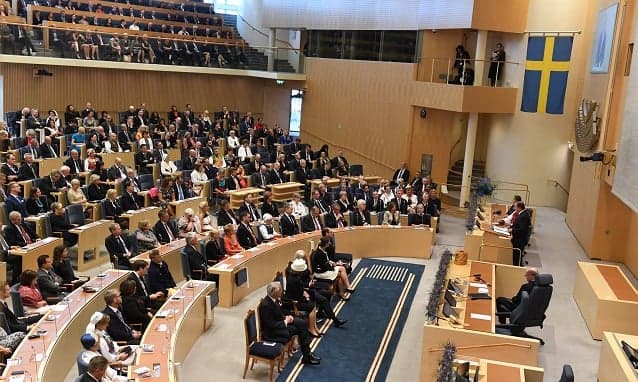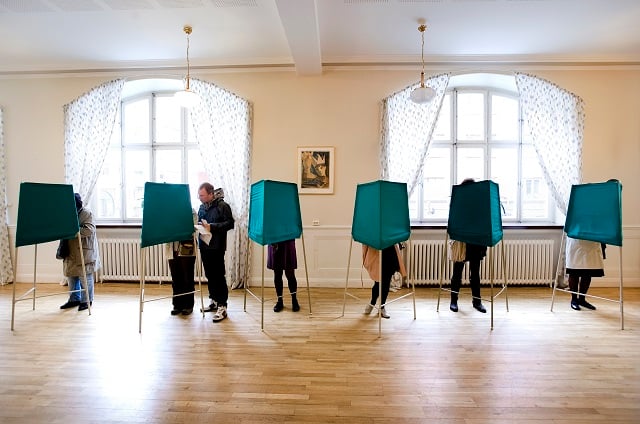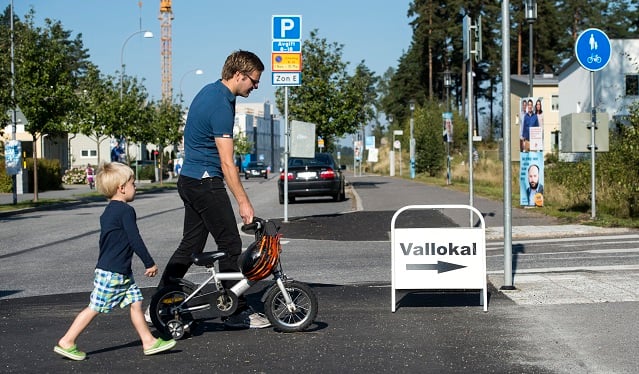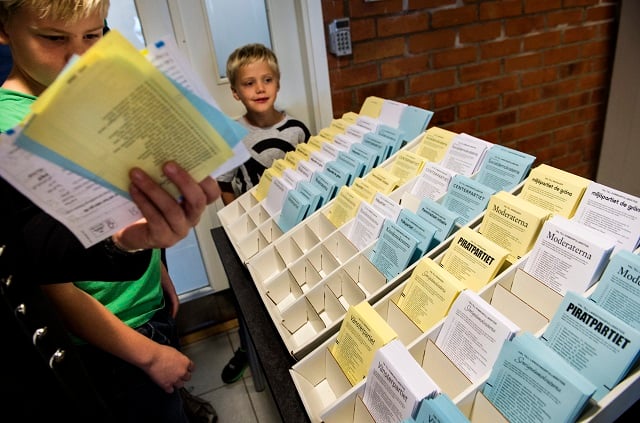How to vote in the 2018 Swedish election

Sweden's next general election is scheduled for September 9th, 2018, and you may be entitled to cast a vote on the day even if you're not a Swedish citizen. Here's how, plus what you should know about the Swedish political system before you head to the polls.
How Sweden is run
There are three different levels of government in Sweden: the national parliament (Riksdag) which has 349 seats, the 20 county councils (landsting), and 290 municipal assemblies (kommunfullmäktige). These three levels don't form a hierarchy but rather each has its own areas of responsibility.
Sweden holds elections for each of these three bodies every four years, always on the second Sunday in September. In 2018, that means the election falls on September 9th.
Since the 2014 elections, Sweden has been led by a minority government made up of Prime Minister Stefan Löfven's Social Democrats (S) and the Green Party (MP), whose spokesperson Isabella Lövin is deputy prime minister.
For eight years before that, the country was governed by the centre-right Alliance, made up of the Moderate Party (M), the Liberal Party (L), the Centre Party (C), and the Christian Democrats (KD).
The seventh and eighth parties represented in parliament are the Sweden Democrats (SD) and the Left Party (V).
Who can vote?
To vote in Riksdag (parliamentary) elections, you must be a Swedish citizen and aged over 18 on the day of the election.
Non-Swedish citizens can vote in county and municipal elections if they are citizens of an EU country, Iceland or Norway. Citizens of other countries also get the right to vote in these elections if they have been registered as a permanent resident in Sweden for three consecutive years before the vote.
Meanwhile, Swedish citizens living abroad can also vote in parliamentary elections; they get this right automatically for their first ten years abroad and after that need to apply to the Swedish Tax Agency (Skatteverket) every ten years to remain on the electoral register. Swedes who are temporarily abroad over the date of the election can vote by post, in an embassy, or by proxy.

People casting their votes in Sweden. Photo: Dan Hansson/SvD/SCANPIX
Around 7.3 million people will be eligible to vote in this year's parliamentary election, according to preliminary figures from Statistics Sweden in September. This is up by 98,000 on the 2014 figure, though a drop is expected in the number of first-time voters and those aged between 18 and 24.
More foreign citizens are eligible to vote in municipal elections, with around 580,000 predicted to cast their ballots. That represents 7.4 percent of the total number of voters in municipal elections.
Sweden has a high voter turnout, with around 86 percent of the eligible population voting in the 2014 election.
How do I vote?
In the weeks leading up to the election, voting cards are sent out to all eligible voters from the Election Authority, also known as Valmyndigheten. These are sent to the address you are registered at with Skatteverket, so it's important to make sure your personal details are up to date.
This letter will also include information about the location and opening time of your nearest polling station on election day. These are municipal buildings, usually schools or libraries. In some locations, it's possible to cast your vote in advance, starting 18 days before the day of the election; if you do this, you can use any advance polling station, but if you vote on the day, you must go to your designated location.

Voters head to the polls in Sundbyberg. Photo: Pontus Lundahl/TT
If you have a good reason (including illness or disability) you can vote by proxy instead, in which case someone else will cast your vote on your behalf.
When you vote, you must take ID with you.
At the polling booth, there are different ballot papers for each of the three elections taking place: yellow papers are for the Riksdag elections, blue for the county council, and white for the municipal council.
There are also different kinds of ballot papers, allowing you to vote either for a particular party (without identifying a specific candidate), to choose from a list of candidates as well as parties, or to vote using a blank ballot paper. On blank ballot papers, you can write down any party and candidate. In theory, it's possible to write anyone's name, and if that person got a large enough proportion of votes, they would be elected.
You then put the ballot paper you picked in an envelope and hand it to the election officer in the room.
And remember: in Sweden, voting is done by a secret ballot, so you do not need to tell anyone who you voted for if you don't want to. You're allowed to collect several different ballots before you go behind the screen to vote (only put one in the envelope though), if you want to make sure nobody suspects who you're voting for.

Ballot papers at a polling station in 2014. Photo: Pontus Lundahl / TT
How is the winner chosen?
Sweden has a one-chamber system, and MPs are elected using proportional representation under a similar system to many European countries. This means that the number of seats each party gets in parliament roughly equates to their share of the nationwide vote.
However, parties must gain at least four percent of the national vote in order to enter parliament, or three percent to enter a county council or regional assembly. For municipal assemblies, the threshold is either two or three percent, depending on how many constituencies are in the municipality.
Sweden is divided into 29 constituencies for parliamentary elections (roughly one for each of the 21 counties, with the larger counties of Stockholm, Skåne, and Västra Götaland divided up further), each of which has between two and 43 seats depending on their population. Fixed constitency seats make up 310 of parliament's 349 seats, with the remaining 39 distributed so that each party's proportion of seats matches up to their proportion of the national vote as closely as possible.
If one single party gains more than 50 percent of the vote, its leader becomes prime minister, but this is very rare in Sweden. Usually, the party that wins the largest number of seats will try to form a government by building a coalition with other parties that hold similar stances. For example, the current government is a red-green coalition made up of the Social Democrats and the Green Party.
Comments
See Also
How Sweden is run
There are three different levels of government in Sweden: the national parliament (Riksdag) which has 349 seats, the 20 county councils (landsting), and 290 municipal assemblies (kommunfullmäktige). These three levels don't form a hierarchy but rather each has its own areas of responsibility.
Sweden holds elections for each of these three bodies every four years, always on the second Sunday in September. In 2018, that means the election falls on September 9th.
Since the 2014 elections, Sweden has been led by a minority government made up of Prime Minister Stefan Löfven's Social Democrats (S) and the Green Party (MP), whose spokesperson Isabella Lövin is deputy prime minister.
For eight years before that, the country was governed by the centre-right Alliance, made up of the Moderate Party (M), the Liberal Party (L), the Centre Party (C), and the Christian Democrats (KD).
The seventh and eighth parties represented in parliament are the Sweden Democrats (SD) and the Left Party (V).
Who can vote?
To vote in Riksdag (parliamentary) elections, you must be a Swedish citizen and aged over 18 on the day of the election.
Non-Swedish citizens can vote in county and municipal elections if they are citizens of an EU country, Iceland or Norway. Citizens of other countries also get the right to vote in these elections if they have been registered as a permanent resident in Sweden for three consecutive years before the vote.
Meanwhile, Swedish citizens living abroad can also vote in parliamentary elections; they get this right automatically for their first ten years abroad and after that need to apply to the Swedish Tax Agency (Skatteverket) every ten years to remain on the electoral register. Swedes who are temporarily abroad over the date of the election can vote by post, in an embassy, or by proxy.

People casting their votes in Sweden. Photo: Dan Hansson/SvD/SCANPIX
Around 7.3 million people will be eligible to vote in this year's parliamentary election, according to preliminary figures from Statistics Sweden in September. This is up by 98,000 on the 2014 figure, though a drop is expected in the number of first-time voters and those aged between 18 and 24.
More foreign citizens are eligible to vote in municipal elections, with around 580,000 predicted to cast their ballots. That represents 7.4 percent of the total number of voters in municipal elections.
Sweden has a high voter turnout, with around 86 percent of the eligible population voting in the 2014 election.
How do I vote?
In the weeks leading up to the election, voting cards are sent out to all eligible voters from the Election Authority, also known as Valmyndigheten. These are sent to the address you are registered at with Skatteverket, so it's important to make sure your personal details are up to date.
This letter will also include information about the location and opening time of your nearest polling station on election day. These are municipal buildings, usually schools or libraries. In some locations, it's possible to cast your vote in advance, starting 18 days before the day of the election; if you do this, you can use any advance polling station, but if you vote on the day, you must go to your designated location.

Voters head to the polls in Sundbyberg. Photo: Pontus Lundahl/TT
If you have a good reason (including illness or disability) you can vote by proxy instead, in which case someone else will cast your vote on your behalf.
When you vote, you must take ID with you.
At the polling booth, there are different ballot papers for each of the three elections taking place: yellow papers are for the Riksdag elections, blue for the county council, and white for the municipal council.
There are also different kinds of ballot papers, allowing you to vote either for a particular party (without identifying a specific candidate), to choose from a list of candidates as well as parties, or to vote using a blank ballot paper. On blank ballot papers, you can write down any party and candidate. In theory, it's possible to write anyone's name, and if that person got a large enough proportion of votes, they would be elected.
You then put the ballot paper you picked in an envelope and hand it to the election officer in the room.
And remember: in Sweden, voting is done by a secret ballot, so you do not need to tell anyone who you voted for if you don't want to. You're allowed to collect several different ballots before you go behind the screen to vote (only put one in the envelope though), if you want to make sure nobody suspects who you're voting for.

Ballot papers at a polling station in 2014. Photo: Pontus Lundahl / TT
How is the winner chosen?
Sweden has a one-chamber system, and MPs are elected using proportional representation under a similar system to many European countries. This means that the number of seats each party gets in parliament roughly equates to their share of the nationwide vote.
However, parties must gain at least four percent of the national vote in order to enter parliament, or three percent to enter a county council or regional assembly. For municipal assemblies, the threshold is either two or three percent, depending on how many constituencies are in the municipality.
Sweden is divided into 29 constituencies for parliamentary elections (roughly one for each of the 21 counties, with the larger counties of Stockholm, Skåne, and Västra Götaland divided up further), each of which has between two and 43 seats depending on their population. Fixed constitency seats make up 310 of parliament's 349 seats, with the remaining 39 distributed so that each party's proportion of seats matches up to their proportion of the national vote as closely as possible.
If one single party gains more than 50 percent of the vote, its leader becomes prime minister, but this is very rare in Sweden. Usually, the party that wins the largest number of seats will try to form a government by building a coalition with other parties that hold similar stances. For example, the current government is a red-green coalition made up of the Social Democrats and the Green Party.
Join the conversation in our comments section below. Share your own views and experience and if you have a question or suggestion for our journalists then email us at [email protected].
Please keep comments civil, constructive and on topic – and make sure to read our terms of use before getting involved.
Please log in here to leave a comment.